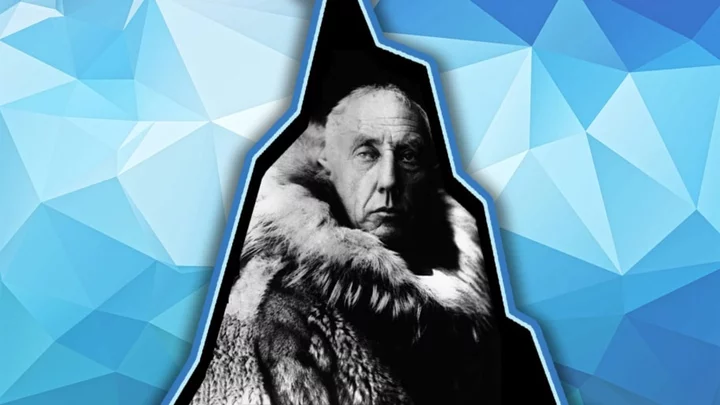Some polar explorers have one major “first” to their name. With Roald Amundsen, it’s hard to choose just one. The Norwegian titan of ice went everywhere from the South Pole to … well, the North Pole. Here are eight things to know about his storied career (and its tragic finale).
1. Sir John Franklin inspired Roald Amundsen to become a polar explorer.
Roald Amundsen was born in Borge, Norway, in July 1872 and raised in nearby Oslo. He spent his teen years living with his mother; his father died when Amundsen was 14 years old, and his older brothers left home soon after. Though Amundsen’s mother wanted him to become a doctor, he’d harbored a secret interest in polar exploration since age 15, when he first read books by Sir John Franklin (commander of the ill-fated Franklin expedition).
“Strangely enough the thing in Sir John’s narrative that appealed to me most strongly was the sufferings he and his men endured,” Amundsen wrote in his 1927 autobiography. “A strange ambition burned within me to endure those same sufferings.”
The teenaged Amundsen took it upon himself to train for those sufferings by partaking in the two sports his community had to offer—football (a.k.a. soccer), which he disliked, and skiing, which he adored—and sleeping with the windows open during the winter, “even in the bitterest weather.” In keeping with his mother’s wishes, Amundsen studied medicine at university. But she died before he graduated, and he dropped out “with enormous relief” to pursue exploration instead.
2. Amundsen was on the first expedition to overwinter in the Antarctic.
In 1897, at 25 years old, Amundsen was appointed first mate aboard the Belgica, a Belgian ship headed to explore the Antarctic region. The ship ended up locked in pack ice for over a year—from February 1898 to March 1899—making it the first expedition in history to spend an entire winter in the Antarctic. It didn’t go very well: Scurvy ran rampant through the crew, and some of its members experienced bouts of insanity. (Scientist Emil Racoviță did his best to entertain himself and others with humorous drawings of his comrades.)
American surgeon Frederick Cook—who’d later gain fame for his much-disputed claim of having reached the North Pole first—proved especially useful during this protracted stopover, ameliorating scurvy’s effects by making the men eat fresh seal and penguin meat (Amundsen called the latter “absolutely excellent”). And when they finally spotted some open water in the distance in early 1899, it was Cook who suggested that they create a canal by hacking their way through the ice—a painstaking, weeks-long effort that did eventually pay off. The Belgica made it to Chile on March 28, 1899, and then returned to Europe.
For all its hardships, the trip didn’t dull Amundsen’s enthusiasm for polar exploration (and despite Cook’s later troubles, he and Amundsen remained lifelong friends). “A more glorious spectacle can hardly exist than these moonlit nights on the ice,” Amundsen wrote in his journal during the expedition. “It is a marvelous feeling that grabs one.”
3. He led the first expedition that sailed through the Northwest Passage …
For centuries, explorers were obsessed with finding a sea route through the Canadian Arctic that linked the Atlantic and Pacific Oceans. The hunt for this so-called Northwest Passage claimed many lives, Sir John Franklin and his cohort of 128 men among them. Irish explorer Robert McClure was technically the first to navigate the Northwest Passage in 1854 (ironically, while on an unsuccessful mission to rescue Franklin), but he didn’t do it all by boat—his journey also entailed traipsing over ice.
About half a century later, Amundsen became the first person to actually sail the entire Northwest Passage. In June 1903, he and six men set off from Europe in a 72-foot-long motorized sloop called the Gjøa. It took them a good three years to make it all the way to the Pacific by way of the Bering Strait, a voyage that included two years of collecting scientific data and learning from Inuit in a bay off King William Island and then another winter waiting for ice to break up off Herschel Island, near the present-day border of the Yukon Territory and Alaska on the Arctic Ocean.
Sailing from King William Island to Herschel Island was by far the most treacherous leg of the trip: Amundsen barely ate or slept as his team coaxed the Gjøa through the shallow Simpson Strait. He called it “the longest three weeks of my life.” So evident was the strain that when the Gjøa came upon a whaling ship on the other side of the strait, Amundsen said his “age was guessed to be between 59 and 75 years.” He was 33.
In the late summer of 1906, Amundsen and company arrived in Nome, Alaska, to great fanfare. An American steam launch hoisted the Norwegian flag and ushered the explorers to shore, where “a jubilant roar of welcome issued from a thousand throats, and through the darkness of the night a sound burst forth that thrilled me through and through, bringing tears to my eyes,” Amundsen wrote. It was the Norwegian national anthem.
4. … And the first expedition to reach the South Pole.
For his next feat, Amundsen planned to take a page out of fellow Norwegian explorer Fridtjof Nansen’s book and intentionally let his ship get stuck in pack ice, which would ideally float him along to the North Pole. Nansen even let Amundsen take his ship—a lightweight wooden vessel called the Fram (Norwegian for “forth”). But in September 1909, days before the trip, Amundsen learned that two explorers—his old friend Frederick Cook, and another American named Robert Peary—had separately claimed to be the first man to reach the North Pole.
Knowing the financial prospects would be better if he achieved another “first,” Amundsen set his sights instead on the as-yet-unreached South Pole—without informing most of his crew or anyone in Norway about his change of plans, least of all Nansen, whose ship he had borrowed. This pitted him against British explorer Robert Falcon Scott, who was also headed to the South Pole and had told the world of his quest. Scott learned of his rival’s plan en route to Antarctica, and even he ran into Amundsen briefly near their base camps. On October 20, 1911—after a few trips to set up supplies depots along the path to the pole in February 1911, a long winter at camp in the Bay of Whales, and one false start to reach their destination in September 1911—Amundsen and four companions set off by dog sledge and skis on a history-making slog across the ice.
They planted a Norwegian flag at the South Pole in mid-December, beating Scott by about a month. “The worst has happened, or nearly the worst,” Scott wrote upon realizing that the Norwegians had already come and gone from the pole. “All the day dreams must go; it will be a wearisome return.” It was worse than wearisome: Scott and his party of four perished on the way back.
5. Amundsen tried and failed to tame a polar bear.
Amundsen spent the late 1910s and early 1920s on a successful voyage on his ship Maud through the Northeast Passage, a sea route from the Atlantic to the Pacific Ocean by way of northern Eurasia. During the expedition, Amundsen suffered a broken arm and carbon monoxide poisoning, and he narrowly survived a polar bear attack when his arm was still healing.
It wasn’t his only run-in with a polar bear: In April 1920, a Siberian trader sold him a cub, whom Amundsen named Marie and tried his darnedest to train. “It is not easy to make friends with Marie, but it may happen,” he wrote. He fed her lard (which she loved), took her on leashed walks (which she didn’t), and acclimated her to being pet and even carried. But the explorer learned pretty quickly that taming a rapidly growing wild animal was beyond his skill set. “[When] I came with milk to her in the morning, she came right at me in full rage. Under an experienced trainer she might become well-mannered, but I had to give it up,” he wrote on June 17. That same day, he euthanized her with chloroform.
Amundsen had Marie taxidermied, and she’s currently on display in the study at his home in Uranienborg, Norway.
6. He had two Indigenous foster daughters.
During his expedition through the Northeast Passage, Amundsen and his crew spent a lot of their time with the Chukchi, a community of Indigenous Siberians. Some Chukchi people worked aboard Amundsen’s ship, including Kakot, a widower who brought along his ailing 4-year-old daughter, Kakonita (Nita, for short).
Nita charmed Amundsen as he nursed her back to health; he described her as “terribly naughty, but absolutely hilarious” and delighted in her calling him “Grandpa.” When Kakot seemed to be on the verge of remarrying, Amundsen decided to adopt Nita. “I am fond of her and do not want to see her in the hands of a step-mother,” he wrote. It’s unclear if Kakot had a say in the matter.
Before heading back to Norway, Amundsen enlisted Camilla Carpendale—the 11-year-old (or thereabouts) daughter of a Chukchi woman and an Australian trader—as a companion for Nita. Camilla’s father had agreed to the plan in part because Amundsen promised to send his daughter to school, which he did. “In spite of his busy life as an explorer, he was very fond of little children, used to play with us frequently, and always was looking after our health,” Nita told the Edmonton Journal in 1943.
Ultimately, though, Amundsen failed pretty spectacularly at fatherhood. The girls were often looked after by Amundsen’s two brothers and their families while he was away; and when he went bankrupt in 1924, his brother Gustav sent the girls—alone—to the U.S., where they endured a stint in a San Francisco orphanage before eventually making it back to Camilla’s family, who took them both in. Camilla and Nita each eventually settled in Canada with their own husbands and families.
7. He was a member of what may have been the first flight over the North Pole.
In the mid-1920s, Amundsen turned his attention from polar seas to the skies above them. In 1925, he was part of a team that set a new record for the northernmost point ever reached by aircraft (87°44’ North). That flight was by seaplane; his most notable one would happen the following year in a dirigible called the Norge.
On May 11, 1926, Amundsen set off in the Norge from Svalbard with more than a dozen other men. Among them were the Norge’s engineer and pilot, Italian aviator Umberto Nobile; Lincoln Ellsworth, an American explorer and the expedition’s financier; and Oscar Wisting, a key member of Amundsen’s trips on the Maud and the Fram. Three days later, they landed in Teller, Alaska, having achieved their goal of traversing the Arctic Ocean. They’d also flown right over the North Pole, dropping national flags over the spot to mark the occasion. (Amundsen rather scathingly wrote that the Norge “looked like a circus wagon of the skies” as Nobile flung “armfuls” of Italian flags over the side. The two didn’t really get along.)
The Norge party has somewhat of a valid claim to having been the first expedition to cross the North Pole. Both Peary’s and Cook’s claims are hotly contested, as is that of Richard E. Byrd, who flew over the pole just days before the Norge did. At the very least, you could say that Amundsen and company made the first undisputed crossing.
8. Amundsen disappeared in 1928.
In the late spring of 1928, Amundsen spearheaded a rescue mission to locate Nobile’s airship Italia, which had gone missing over the Arctic Ocean. He and a few other men departed in a French seaplane prototype, the Latham 47.02, from Tromsø, Norway, on June 18. They were never heard from again.
On August 31, a fishing boat north of Tromsø came upon a damaged float from the Latham; other debris turned up along the Norwegian coastline in the following months. Theories about the fate of the rescuers abound, the most entertaining (but least plausible) of which posits that Ellsworth rescued Amundsen, who lived the rest of his life off the radar in Mexico. What most likely happened is that the whole crew perished in or after an accident.
For what it’s worth, it’s pretty much exactly how Amundsen wanted to go out—he said as much in an interview just weeks before the Latham’s launch: “Ah! If you only knew how splendid it is up there! That’s where I want to die; and I wish only that death will come to me chivalrously, will overtake me in the fulfillment of a high mission, quickly, without suffering.”
This article was originally published on www.mentalfloss.com as 8 Facts About Polar Explorer Roald Amundsen.









